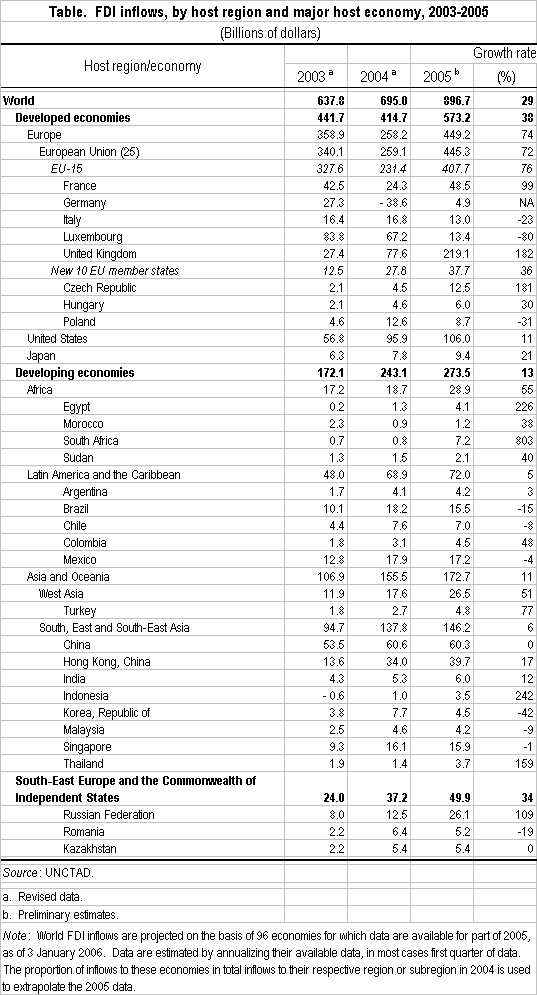Foreign direct investment worldwide surged to an estimated US$897 billion in 2005 - up 29% from the preceding year - and a four-year slump in flows to developed countries was sharply reversed, according to UNCTAD data released today.
Such investment -- or FDI -- in the world´s wealthier nations jumped an estimated 38% for the year, led by mounting investment in the United Kingdom, which led the world in FDI for the first time since 1977 (1).
Increases were also recorded for developing countries (an estimated 13% climb as compared with 41% in 2004) and for the countries of South-East Europe and the Commonwealth of Independent States (CIS)(2).
Developed countries: FDI inflows rose from US$415 billion in 2004 to US$573 billion in 2005. The bulk of this increase was accounted for by increased investment in the United Kingdom, which reported inflows of US$219 billion, twice that of the United States (table). This is the highest figure ever recorded for a European country. However, the increase was largely accounted for by the merger of Shell Transport and Trading Company Plc and Royal Dutch Petroleum Company into Royal Dutch Shell, a Dutch company, for some US$100 billion(3). Other reasons for the significant increase in FDI included the virtual end of large loan repayments from affiliated firms to their parent firms abroad. In Germany, for example, such repayments had thrown 2004 FDI inflows into negative territory, at -US$39 billion (table).
FDI increases also were underpinned by a favourable business climate (rising profits) and economic growth. Mergers and acquisitions (M&As) - including cross-border activity - increased 40% for the year, and amounted to roughly US$2.9 trillion in 2005(4) , partly reflecting higher share prices in many major financial markets. Thus, most major FDI recipients among developed countries (Belgium, Canada, France, Germany, Ireland, Netherlands, the United States) recorded high inflows.
FDI to the EU-15 came to an estimated US$408 billion -- up 76% -- helped by the surge in investment in the United Kingdom and by further market integration in the Euro zone. FDI inflows to 10 new EU members rose by 36% to a record level of US$38 billion, mainly due to high rates of reinvested earnings.
Developing countries: Overall, FDI inflows to the developing world continued to rise in 2005 - they were up 13%, to an estimated US$274 billion. Following 2004´s significant increase of 41%, this brought FDI to the highest level ever for developing countries. There were increases in all sub-regions.
- FDI in Africa rose in all the major oil-producing countries (including the Sudan) as well as in Egypt and South Africa. Overall, FDI flows to the region reached an estimated US$29 billion a record (table). While these increases are significant in an historical context, it should be stressed that they relate mainly to the oil sector and to other natural resources industries.
- FDI flows to Asia continued their upward trend in 2005. Flows rose about 11% to an estimated US$173 billion (table). For the first time since 1999, FDI to China - the largest recipient in Asia as well as among all developing countries - did not increase. They remain almost unchanged at an estimated US$60 billion, while FDI to the Republic of Korea and to Malaysia fell. Increased investment in Hong Kong (China), Indonesia and Thailand more than compensated for these declines, however. India saw its inflows jump from US$5 billion to an estimated US$6 billion. Among various sub-regions, the sharpest growth was in West Asia, where FDI leaped an estimated 50%, largely because of increased investment in the oil sector and related activities, and in telecommunications and real estate. Saudi Arabia and the United Arab Emirates saw the highest increases there.
- FDI flows to Latin America and the Caribbean also continued their upward trend during 2005, but at a lower pace than in 2004 (table). They rose around 5% to an estimated US$72 billion. Preliminary data suggest that Brazil experienced a decline of 15%, to US$16 billion, and yielded the position of the top recipient in the region to Mexico, even though, with less FDI going to the financial sector, flows to Mexico declined by 4% to $17 billion. Chile maintained a high level of inflows (due in part to rising prices for copper), although its total was slightly lower than in 2004. Colombia registered a significant increase, mainly due to a cross-border US$4.8 billion M&A deal between Bavaria and SABMiller.
South East Europe and the CIS: FDI inflows reached an estimated US$50 billion. In Russia alone, FDI doubled from its 2004 level (from US$12 billion to US$26 billion) (table). High oil prices in 2005 apparently further accelerated inward FDI. Chinese FDI is emerging in the region (e.g. Petrokazakh was acquired by China National Petroleum Corporation (CNPC) in 2005 for US$4.2 billion).
ANNEX
Table
Table. FDI inflows, by host region and major host economy, 2003-2005


